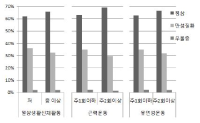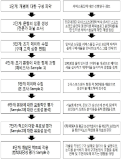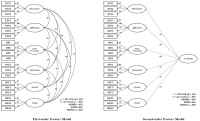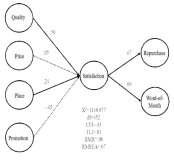
This study examined the association between physical activity (PA) and the prevalence of chronic disease and chronic depression. Additionally, the relationships between PA and health-related quality of life (HRQoL) among general population, categorized by healthy, chronic disease and depression were investigated. Cross-sectional data includes 9,739 participants (4,351 males, 5,659 females, over 19 years old) who completed physical activity, chronic disease and HRQoL questionnaires from The Fifth Korea National Health and Nutrition Examination Survey (KNHANES). Complex samples frequency, descriptive, cross-tab and logistic analysis were used. Estimated prevalence of chronic disease and depression were significantly different between PA levels and frequency. Based on odds ratios (OR) and 95% confidence intervals (CI), participating in lower levels of daily PA including less resistance and flexibility exercise were associated with an increased likelihood of chronic disease. Less frequency of resistance PA was also associated with an increased likelihood of depression. Estimated prevalence of HRQoL was different according to PA in the healthy and chronic disease populations. Adjusted OR and confidence intervals represented through lower levels of daily PA and less frequency of resistance PA were associated with an increased likelihood of poor HRQoL in the chronic disease population. No significant OR between PA and HRQoL in the depression population was observed.

PURPOSE This study assessed Taekwondo’s impact on functional fitness and health-related quality of life (HRQoL) in older women from South Korean multicultural families. METHODS Through purposive sampling, 16 participants were divided into an experimental group that underwent a 12-week Taekwondo training program and a control group without this intervention. RESULTS Pre- and post-intervention assessments showed that the Taekwondo group experienced significant improvements in both functional fitness and HRQoL. These findings suggest that Taekwondo could be an effective physical activity for enhancing the well-being of older women in multicultural families, advocating for inclusion of culturally sensitive physical activities in health promotion programs targeting this demographic. CONCLUSIONS This study contributes to the growing body of evidence supporting physical activity’s benefits for elderly populations, particularly in multicultural family dynamics.
Purpose The purpose of this study was to investigate the effects of aerobic exercise intensity on body composition, health related fitness, and quality of life in elderly women. Methods 48 elderly women over 65 years of age without physical and mental problems were assigned to four groups: control group, low intensity, moderate intensity, and high intensity aerobic training group. The aerobic exercise group applied a heart rate reserve (HRR) to low-intensity group (HRR 40-55%), moderate intensity group (HRR 55-70%), high intensity group (HRR> 70%) for 12 weeks, 3 times a week for 20 minutes a day. Subjects of the control group were to maintain their usual lifestyles during the same intervention period. Body composition, health related fitness, and quality of life were measured and analyzed using repeated two-way ANOVA. Results The main results obtained in this study are as follows. 1) There was a significant decrease in sitting forward bending in the low intensity group and a significant increase in EQ-VAS. 2) There was a significant decrease in body weight, BMI, and 6 minutes walking in the moderate intensity group, and a significant increase in grip strength and EQ-VAS. 3) The high intensity group showed a significant decrease in weight, BMI, waist circumference, sitting forward bending, and 6 minutes walking, and a significant increase in grip strength, sit and stand, functional reach, and VO2max. On the other hand, there was no significant change in all variables in the control group. Conclusions In conclusion, aerobic training was found to be effective for body composition, health related fitness and quality of life in elderly women. In particular, it can be concluded that high intensity aerobic training is effective for health related fitness, and low and moderate intensity aerobic exercise is effective for improving quality of life.

[Purpose] The purpose of this research is to empirically analyze the relationship between self-determination and relationship commitment, customer orientation, service quality, and relation continuity intention of fitness center customers through structural equation model analysis. [Methods] For this purpose, this study set 242 members at the five fitness centers located in Seoul as the research subjects. In an effort to verify the proposed structural model, this study used IBM SPSSWIN Ver. 21.0 and AMOS 18.0. [Results] As a result, first, autonomy had a positive effect on relationship commitment. Second, competence didn’t had a positive effect on relationship commitment. Third, relatedness had a positive effect on relationship commitment. Fourth, relationship commitment had a positive effect on customer orientation. Fifth, relationship commitment had a positive effect on service quality. Sixth, customer orientation had a positive effect on relation continuity intention. Seventh, service quality had a positive effect on relation continuity intention


The purpose of this study was (a)to clearly define the concept of service quality as it relates to the online sports shopping mall, and (b)to develop and validate a psychometrically sound measurement scale, (c)examine the relationship among service quality and shopping satisfaction and intention of recommendation for marketing strategy internet sport shopping mall management. Following Churchill’s(1979) suggestions, the author developed internet Sports Shopping Mall Service Quality(E-SSMSQ). For the development E-SSMSQ (1)literature review, (2)focus group interview, (3)in-depth interviews (4)pilot test(n=97), (5)first data collected(n=459), (6)Frequency analysis, descriptive analysis, exploratory factor analysis(EFA) and reliability analysis for items evaluation, (7)confirmatory factor analysis(CFA) and correlation analysis for scale validation, (8)CFA, correlation analysis and structural equation model(SEM) test for predictive validity used second data collected(n=471). The current study conceptualized the service quality in the context E-SSMSQ by incorporating interaction, efficiency, order processing, information, security, and design. The authors also developed 20 items E-SSMSQ. The results of SEM support the psychometric property of the scale. First, interaction, efficiency and order processing of E-SSMSQ had significantly influence on internet shopping mall satisfaction. Interaction, efficiency, security, and design of E-SSMSQ had significantly influence on internet shopping mall intention of recommendation.


Purpose The valuable impacts of exercise-intervention in diverse type of cancer patients were rationally well-prescribed, though many experimental and review researches already performed in this fields. Generally, cancer-related fatigue and pain remains one of the most prevalent problems for cancer populations. Therefore, exercise has become increasingly significant in cancer prevention and progression. The purpose of this recent study was to analyze the combined exercise program on cancer-related fatigue, pain, quality of life and cancer prognosis in diverse type of cancer patients. This study analyses the safety and feasibility of exercise intervention in diverse stages of cancer patients such as early stage, advanced stage and even metastatic periods in cancer populations. we also wanted to know the impacts of dose-response trial of aerobic and resistance exercise on quality of life in cancer survivors. Methods we conducted a comprehensive PubMed/MEDILINE electronic database from Jan 2015 to August 2020. The reference lists of eligible experimental research articles and relevant systemic review articles were checked. Inclusion criteria were adult cancer survivors from randomized controlled trials performing well-tailored exercise intervention programs to diverse type of cancer patients, Using predefined search items ‘exercise-intervention, cancer & immunology’. Based on reference search, more than 100 articles were identified whereas 30 research papers met the inclusion criteria and were well connected with exercise-intervention and cancer progression. we analyzed the connections between physical exercise and cancer intervention in the main text. Results Moderate to vigorous exercise (aerobic and resistance exercise) revealed to decreased level of cancer-related fatigue, pain, and cancer-related symptoms, however increased level of sleep quality, activities of daily living, exercise performance and health- related quality of life. Exercise intervention reduced pro-inflammatory markers and oxidative stress as well as insomnia, fatigue, pain symptoms whereas it enhanced the antioxidant systems and immune functions. In addition, home-based aerobic physical exercise might enhance muscular strength and quality of life in many types of cancer survivors. Psychological intervention also effective for reducing cancer-related fatigue and pain during and after cancer treatment. they might be the much better intervention than available pharmaceutical options. we believe that it is the related mechanisms of immune cell mobilization and activation such as NK cells which is induced by the activation of sympathetic system during and after physical exercise. Conclusion According to the aforementioned results, it was concluded that implementation of exercise intervention appear to be the best non-pharmaceutical interventions for cancer populations, and also revealed to be safe and feasible in early and advanced stages, although not in the metastatic periods. Sometimes, psychological intervention such as mindfulness-based stress reduction (MBSR) might be useful in reducing anxiety, depression, fatigue, pain and enhancing quality of life, quality of sleep for cancer populations. we can conclude, exercise-intervention might not just be prevention effect but might be therapeutics, however more studies are urgently needed to confirm the exercise intervention on the NK-receptors activation and immune connection of cancer populations.
The purpose of this study was to investigate the effects of National Fitness Award program group exercise classes on daily fitness and balance-confidence among the elderly participants(n=496, 80.2% women). This study investigated body composition, daily fitness, and balance-confidence, and quality of life among the subjects who participated in the combined exercise program of improving physical fitness class for 8-week in the 10 national physical fitness certification centers by the demonstration project for the elderly of 2013 Korean National Fitness 100 project. Body composition and physical fitness for daily living were defined by Korean National Fitness 100 project for elderly, also the balance-confidence and health-related questionnaires were added. The following results were obtained by comparing the pre-test and post-test. In body composition body weight (p<.05), body mass index (p<.05), fat mass (p<.01), and percent body fat (p<.05) were significantly decreased, but muscle mass was not. Except for walking-around-two-cones-in-a-figure 8, all other daily fitness items such as relative grip strength (p<.001), chair sit to stand, two minutes place to walk, and sit-and-reach significantly increased (p<.01), and timed up and go were significantly decreased (p<.01). In balance confidence rating ABC tests (p<.001) were shown significantly increased. Although, quality of life measured by EQ-5D was not significantly improved, self-health status measured by EQ-VAS (p<.001) showed significant increase. Therefore, the group exercises of National Fitness Award program improved body composition, daily fitness and balance confidence in Korean elderly participants.
PURPOSE This study aimed to identify the dimensions of sport brand authenticity and to develop a valid and reliable scale for measuring such dimensions. METHODS Along with a sequential mixed method design, qualitative researches were conducted (a literature review on brand authenticity and the inherent value of sport, 5 one-to-one expert interviews, and a Delphi survey of 10 researchers). Based on the qualitative research results, an EFA (n=304), 2 times CFA (1st: n=304, 2nd: n=311), and correlation analysis using the other scale (brand relationship quality, brand attachment, brand credibility) were conducted to test reliability, construct validity, and criterion-related validity. RESULTS In the qualitative research results, 8 dimensions with 36 items were extracted; however 6 dimensions (originality, connectedness, legitimacy, authority, sport spirit, and expertise) with 28 items were identified as appropriate structures from EFA and CFA, and the relations between all the dimensions and other scales related to consumer attitude were statistically significant in the correlation analysis. CONCLUSIONS The findings suggest that the scale in this study could provide a new and specific perspective on sport brand authenticity, which is constructed using a general aspect and a sport specific aspect, and an understanding of the concept of sport brand authenticity in other sport industries.
PURPOSE The purpose of this study is to analyze various citation patterns such as the scope and intensity of the academic influence of Korean "Kinesiology" studies. METHODS To this end, this paper collected and analyzed 17,693 target articles published in 22 KCI-accredited “Kinesiology” related journals from 2001 to 2014, and 98,941 citing cases that took advantage of target articles as references. Specifically, this paper analyzed the citation pattern by dividing it into two parts. First, this paper analyzed the distribution of citations in individual target articles and the top-cited articles and top-cited researchers. Second, this paper also analyzed the citing articles; such as in which journal, what academic field, and in what pattern the “Kinesiology” target articles were cited. RESULTS As a result, 15% of the target articles were not cited at all for five years after publication, while 6.8% of papers were cited more than 17 times, which was exceptionally more cited compared to the majority of target articles. There were no research topics exclusively exerting influence in Korean "Kinesiology" research, but relatively many cited thesis topics include 'self-management, 'leisure statement', 'psychological well-being', 'self-confidence', 'service quality', and 'leisure flow'. Besides, the Korean "Kinesiology" articles accounted for 76% of the total of about 98,000 citations, having greater influence within the same academic field than other academic fields. CONCLUSIONS This study contributes to the relevant literature in that it is one of the early endeavors to study the citation pattern for the entire Korean kinesiology articles.

The purpose of this study was to examine the effect of marketing mix on satisfaction, repurchase intention, and word-of-mouth intention. Through the convenience sampling method, a total of 350 spectators from 2013 Son Yeon-Jae Gala Show. Of 350 surveys that were collected, 20 were discarded resulting in 330 usable surveys. By employing independent t-test, confirmatory facor analysis, structural equation modeling through SPSS 20.0 and AMOS 20.0, this study found followings. First, there was difference according to past experience of attending the gala show or watching it on media. Second, quality of performance and place in marketing mix were positively related to satisfaction. Third, satisfaction had a positive influence on repurchase intention and word-of-mouth intention. Fourth, quality of performance and place in marketing mix had a positive influence on repurchase intention and word-of-mouth intention mediated by satisfaction.
